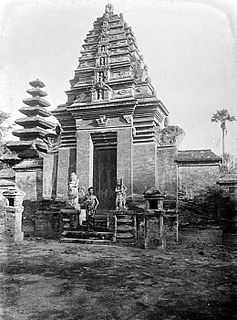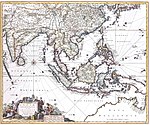
The Klungkung Palace, officially Puri Agung Semarapura, is a historical building complex situated in Semarapura, the capital of the Klungkung Regency (kabupaten) on Bali, Indonesia. The palace (puri) was erected at the end of the 17th century, but largely destroyed during the Dutch colonial conquest in 1908. Today the basic remains of the palace are the court of justice, the Kertha Gosa Pavilion, and the main gate that bears the date Saka 1622. Within the old palace compound is also a floating pavilion, the Bale Kembang. The descendants of the rajas that once ruled Klungkung today live in Puri Agung, a residence to the west of the old palace, which was built after 1929.
Gelgel is a village (desa) in the regency (kabupaten) of Klungkung, on Bali, Indonesia. The village, near the coast four kilometers south of the regency capital Semarapura, contains a number of structures of cultural interest, and is known for its pottery and handwoven ceremonial songket cloth. The height of the village's power came during the kingdom of Gelgel, which dominated Bali from around the early 16th century to 1686. There are no traces left today of the old royal palace (puri). The old ancestral shrine of the ruling dynasti, Pura Jero Agung, is still standing in the old palace area. To the east of Pura Jero Agung is another old temple, Pura Dasar, which is a lowland counterpart of the "mother temple" of Bali, Pura Besakih. The village also contains the oldest mosque in Bali, which was built by Javanese retainers of the old kings.

Dewa Agung or Deva Agung was the title of the kings of Klungkung, the foremost in rank among the nine kingdoms of Bali, Indonesia. It was also borne by other high-ranking members of the dynasty. The term Dewa means "god" and was also a general title for members of the Ksatria caste. Agung translates as "high" or "great". Literally, the title therefore means Great God.

Babad Dalem is a historical account from Bali, Indonesia, which exists in a large number of versions of varying length. The title may be translated as "Chronicle of Kings", although the Balinese babad genre does not quite accord to Western-style chronicles. There are dated manuscripts from the early 19th century onwards, and the original version was very likely written in the course of the 18th century. The author was probably a Brahmin tied to the Klungkung Palace, the most prestigious of the nine pre-colonial royal seats of Bali.
Dalem was a title for the kings of Bali who resided in Samprangan and Gelgel and were descended from the founder-raja Sri Aji Kresna Kepakisan. These kings ruled the island, or at least substantial parts thereof, from maybe the 14th century to the second half of the 17th century. The title literally means "inside", and alludes to his ritual-symbolic role inside the palace (puri). The title is first found in a Dutch report from 1619, which says that the Radia Dalam was the paramount ruler of 33 lesser Balinese lords. The title is used in the chronicle Babad Dalem from the 18th century, which recounts the history of the kings of Bali up the end of the 17th century. After the fall of the Gelgel kingdom in 1686, a daughter kingdom was established in nearby Klungkung. However, the rulers of the Klungkung Palace were usually known by another title, Dewa Agung. In the literature, Dewa Agung is sometimes, although anachronistically, used also for the pre-1686 kings of Bali.

Dalem Baturenggong, also called Waturenggong or Enggong, was a King (Dalem) of Bali who is believed to have reigned in the mid 16th century. He is in particular associated with the golden age of the Balinese kingdom of Gelgel, with political expansion and cultural and religious renovation. In Balinese historiography he represented an epic vision of kingship that served as a model for later rulers on the island.

Sri Aji Kresna Kepakisan was a king of Bali who governed the island under the suzerainty of the Javanese Majapahit Empire. He is supposed to have ruled in the mid-14th century, and to be the ancestor of the later kings of Bali. His historicity is, however, not clearly documented.

Dalem Ketut was a king (Dalem) of Bali who ruled at an uncertain time during the age of the Javanese Majapahit Empire. While first a vassal ruler under the Majapahit kings, he later emerged as the king of a separate island realm. He was also known under the names Sri Smara Kepakisan or Tegal Besung. Dewa Tegal Besung is the earliest deified ruler who is honoured at the Pura Padharman Dalem Gelgel, the most important shrine at the central Balinese temple Pura Besakih.

Dalem Bekung, also known as Pamayun, was a king of Bali who is traditionally dated in the second half of the 16th century. He belonged to a dynasty of kings who were descended from Majapahit on Java, and reigned from their palace (puri) in Gelgel.

Dalem Seganing was a king of Bali who reigned in the first half of the 17th century, his exact dating being still uncertain. He belonged to a dynasty which originated from Majapahit on Java, and ruled from the palace (puri) of Gelgel.

Dalem Di Made was a king of Bali who may have reigned in the period 1623–1642. He belonged to a dynasty that claimed descent from the Majapahit Empire of Java, and kept residence in Gelgel, close to Bali's south coast.
Dewa Pacekan was a prince on the Island of Bali, who possibly ruled the island kingdom for a short time, in 1642–1650. He belonged to a dynasty stemming from the Majapahit Empire of Java, which had its palace (puri) in Gelgel, near Bali's south coast. According to Balinese historiography he was the second son of king Dalem Di Made, who may have died in 1642. In Dutch sources from the 1630s, he appears to be mentioned as 'Patiekan' or 'Paadjakan', son of the current ruler. In the religious text Rajapurana Besakih, he is listed as the last deified ancestor of the Gelgel dynasty. He may therefore have succeeded Dalem Di Made, although later Balinese historical texts do not actually mention him as ruler in his own right. One text mentions that he directed his troops against the army of the Javanese Muslim Mataram kingdom in 1646. This confrontation is also described in Dutch and Javanese sources. His death is placed by Balinese texts in 1650. Dutch sources relate that the Dutch East Indies Company sent an embassy to Bali in 1651, but found on arrival that the unnamed king had recently died, and that chaotic internecine wars raged on the island.
Dewa Cawu was a prince on the Island of Bali, who possibly reigned as king for a short while in the 1650s. He belonged to a dynasty that claimed descent from the Hindu-Javanese Majapahit Empire, and kept its palace (puri) in Gelgel near Bali's south coast.
Samprangan, also spelt Samplangan, is a historical site on Bali, Indonesia. It is situated about one kilometer to the east of Gianyar town. According to Balinese historical tradition, it was the first residence of the dynasty of kings of Bali who descended from the Javanese Majapahit Empire, being established after the Javanese conquest of Bali in 1343. After a few generations, in the late 14th or 15th century, Samprangan was replaced as royal residence by Gelgel further to the east. Today there are hardly any traces left of the old palace compound.

A pura is a Balinese Hindu temple, and the place of worship for adherents of Balinese Hinduism in Indonesia. Puras are built in accordance to rules, style, guidance and rituals found in Balinese architecture. Most puras are found on the island of Bali, where Hinduism is the predominant religion; however many puras exist in other parts of Indonesia where significant numbers of Balinese people reside. Mother Temple of Besakih is the most important, largest and holiest temple in Bali. Many puras have been built in Bali, leading it to be titled "the Island of a Thousand Puras".

The Kingdom of Bali was a series of Hindu-Buddhist kingdoms that once ruled some parts of the volcanic island of Bali, in Lesser Sunda Islands, Indonesia. With a history of native Balinese kingship spanning from the early 10th to early 20th centuries, Balinese kingdoms demonstrated sophisticated Balinese court culture where native elements of spirit and ancestral reverence combined with Hindu influences – adopted from India through ancient Java intermediary – flourished, enriched and shaped the Balinese culture.
Bedulu, also spelt Bedahulu or Bedaulu, is a historical site in Bali, Indonesia. It is situated about two kilometer to the west of today Gianyar town.

Pura Dasar Buana is a Balinese Hindu temple or pura located in Gelgel, Bali, about 3 kilometres (1.9 mi) from Semarapura. Pura Dasar Buana is one of the Pura Dang Kahyangan Jagat, a temple which was built to honor a holy teacher of Hindu teaching. Pura Dasar Buana honored Mpu Ghana, a Brahmin who arrived to Bali from Javanese Majapahit to teach Hinduism in the island.
Nurul Huda Mosque of Gelgel is a historic mosque in Bali, Indonesia. It is considered the oldest mosque in Bali and one of the earliest in the Indonesian archipelago. The mosque is located in the village of Gelgel, Klungkung Regency.





